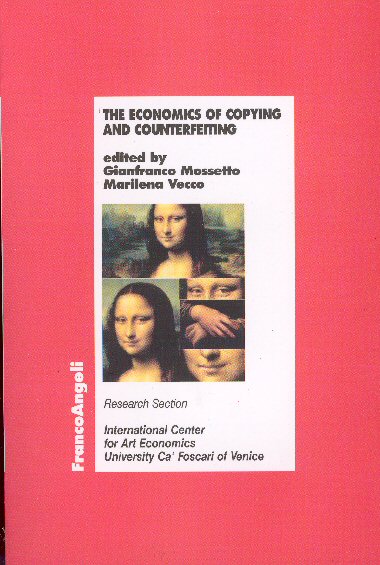| INTRODUCTION by Gianfranco Mossetto and Marilena Vecco |
11 |
| SECTION I - THEORY AND HISTORY |
15 |
| 1. Frey Bruno S., Some Considerations on Fakes in Art. An Economic View |
17 |
| 1.1 A Widespread Activity |
17 |
| 1.2 Dominant Views on Fakes |
18 |
| 1.2.1 The Legal Position |
18 |
| 1.2.2 The Art Historic Position |
20 |
| 1.3 Beneficial Aspects of Imitations |
21 |
| 1.4 Harmful Aspects of Imitations |
23 |
| 1.4.1 Demand |
23 |
| 1.4.2 Supply |
24 |
| 1.5 Quotations as Solutions? |
25 |
| References |
28 |
| 2. Benhamou Françoise and Ginsburgh Victor, Is There a Market for Copies? |
30 |
| 2.1 Introduction |
30 |
| 2.2 Forgeries, Copies and Reproductions |
32 |
| 2.3 Artists, Consumers and Markets |
34 |
| 2.3.1 Artists and their Patrons |
34 |
| 2.3.2 Markets |
37 |
| 2.4 Copies and the Law |
41 |
| 2.4.1 The Legal Definition of Originality |
41 |
| 2.4.2 Public Domain versus Non Public Domain |
43 |
| 2.4.3 Copies as Double and Copyrightable Goods |
44 |
| 2.5 Copies and Art Historians |
46 |
| 2.5.1 Exhibitions and Museums |
47 |
| 2.6 Concluding Comments |
48 |
| References |
49 |
| 3. Mossetto Gianfranco, The Economics of Counterfeiting |
52 |
| 3.1 Introduction |
52 |
| 3.2 The Importance of Being Conterfeited: The "Cuckoo Model" |
53 |
| 3.3 Some Economics of Forgery |
54 |
| 3.4 From Cuckoo to "Pedlar" |
58 |
| 3.5 The "Breath of the Artisf' Model |
64 |
| 3.6 Conclusions |
70 |
| References |
73 |
| 4. Corazza Marco and Funari Stefania, Quantitative Dynamics for the Pedlar Model |
74 |
| 4.1 Introduction |
74 |
| 4.2 Dynamic Behaviour |
75 |
| 4.2.1 Dynamic Demand Function |
76 |
| 4.2.2 The Monopolist's Behaviour |
77 |
| 4.2.3 The Counterfeiter's Behaviour |
79 |
| 4.3 The Model |
81 |
| 4.3.1 Homogeneous Solution |
82 |
| 4.3.2 Particular Solution |
83 |
| 4.4 Stability Conditions |
84 |
| 4.5 Concluding Remarks and Open Items |
89 |
| References |
90 |
| SECTION II - MARKET AND PRICING |
91 |
| 5. Lazzaro Elisabetta, Moureau Nathalie and Sagot-Duvaroux Dorninique, From the Market of Copies to the Market of Fakes: Adverse Selection and Moral Hazard in the Market of Paintings |
93 |
| 5.1 Introduction |
93 |
| 5.2 Definitions of Copies |
95 |
| 5.3 Case 1: A Copy sold as a Copy |
98 |
| 5.3.1 Copies, a Way to diffuse an Original |
98 |
| 5.3.2 Copies, a Vertical Differentiation of the Market |
98 |
| 5.4 Case 2: From the Market of Copies to the Market of Fakes. A Copy sold as an Original |
103 |
| 5.4.1 Causes for the Appearance of Fakes |
103 |
| 5.4.2 Economic Consequences of Fakes on the Market |
105 |
| 5.4.2.1 How can the Adverse Selection Problem be avoided? |
106 |
| 5.4.3 Certificates and Warranties |
107 |
| 5.4.4 Descriptive Catalogue |
108 |
| 5.4.5 Legal Protection |
110 |
| 5.5 Case 3: An Original sold as a Copy |
112 |
| 5.6 Case 4: Nobody knows |
115 |
| 5.7 Concluding Remarks |
116 |
| References |
117 |
| 6. Frank Björn, Art Price Research for Fakes and Imitations |
119 |
| 6.1 Introduction |
119 |
| 6.2 Prices for Fakes: Some Econometric Evidence |
120 |
| 6.2.1 Background and Data |
120 |
| 6.2.2 Results |
124 |
| 6.3 Some Lessons from Imitations |
128 |
| 6.4 Final Remarks |
130 |
| References |
131 |
| SECTION III - LAW ENFORCEMENT |
133 |
| 7. Ricolfi Marco, The Wars on Piracy and their Dilemmas |
135 |
| 7.1 Introduction |
135 |
| 7.2 The Piracy Inducement Dilemma |
136 |
| 7.3 The Downstream Users Dilemma |
140 |
| 7.4 The Multilateral Monopoly Dilemma |
142 |
| References |
145 |
| 8. Silva Francesco and Ramello Giovanni B., Sound Recording Market. The Ambiguous Case of Copyright and Piracy |
146 |
| 8.1 Introduction |
146 |
| 8.2 The Legal Industry: Main Features |
149 |


